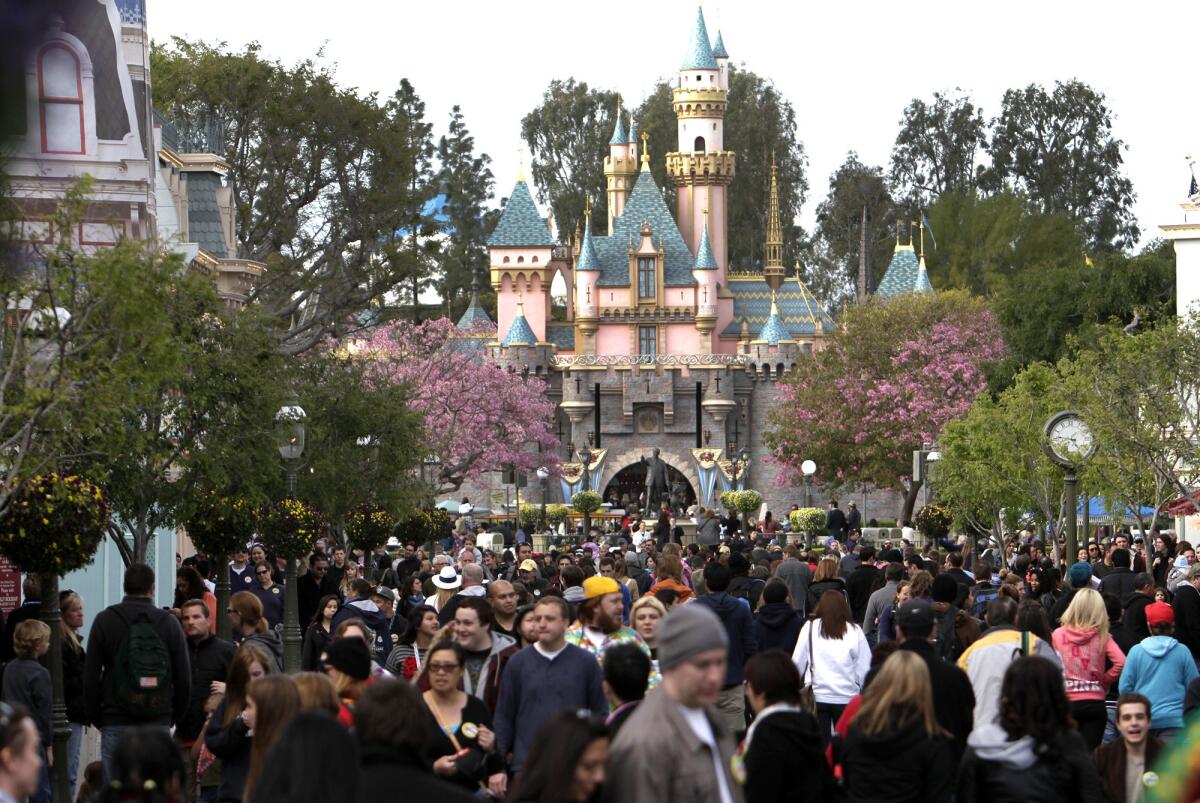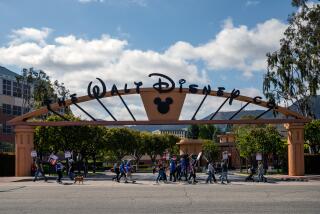Disney theme parks take a $1-billion hit amid coronavirus closures

- Share via
Walt Disney Co., the world’s largest entertainment company, reported quarterly earnings for the first time since the coronavirus crisis shut down domestic theme parks and brought Hollywood to a standstill. As expected, it wasn’t pretty.
The Burbank giant’s profit dropped dramatically during the three months that ended in March, the month that fears of the COVID-19 pandemic closed Disneyland Resort and Walt Disney World, halted film and TV production and suspended live sports indefinitely.
Earnings for the second fiscal quarter fell 63% from the same period last year to 60 cents a share, the company said Tuesday. That was worse than Wall Street anticipated. Analysts polled by FactSet on average had expected 89 cents a share. Net income fell 91% to $475 million.
Disney estimated that the business missed out on $1 billion in operating income because of the theme park closures during the quarter, which ended March 28. About half of the $1-billion hit was from the company’s U.S. theme parks, which were closed for just two weeks during the period. International parks and cruise ships accounted for the rest, Disney said.
Disney closed its domestic parks and Disneyland Paris in mid-March amid the growing public health concerns surrounding the novel coronavirus.
The crisis has taken a major toll on the broader media industry, but Disney in particular has suffered because of its reliance on in-person experiences such as parks, movie theaters, cruise ships and retail stores.
Disney has furloughed much of its staff and cut executive salaries. The impacts on Hollywood’s dominant company could be long-lasting.
The outbreak came just as Disney was transitioning to new leadership, with Bob Iger stepping aside from the chief executive role in late February to make way for his successor, Bob Chapek, who previously ran the parks and resorts empire.
“The challenges we’re now facing are unprecedented,” Iger said on a call with analysts. However, he added, “I have absolute confidence in our ability to get through this challenging period.”
To weather the shutdowns, Disney has added billions of dollars to its debt load, slashed executive salaries and furloughed more than 100,000 of its 223,000 employees. The furloughs have hit tens of thousands of parks and cruise workers , as well as employees at the company’s movie studio division.
“We are fully committed to getting our employees back to work as quickly as the current situation allows,” Chapek said on the call. “While these were not easy decisions, I do believe they have been the right ones.”
The company on Tuesday said it would forgo its semiannual dividend for shareholders, saving about $1.6 billion in cash.
Disney stock fell about 2% in after-hours trading on Wall Street, after the earnings release. Before the financial report, the stock closed down $2.12, or 2%, to $101.06 on Tuesday.
Lightshed Partners analyst Rich Greenfield, a frequent critic of the company, described the coronavirus-driven downturn in stark terms in a blog post for clients. “Disney has gone from being on top of the world a la Lion King, to feeling like Eeyore stuck in the middle of a perfect storm with no end in sight,” Greenfield wrote.
Parks, experiences and products — normally the company’s biggest segment in terms of sales — saw revenue fall 10% to $5.54 billion in the quarter. Operating income was $639 million, down 58% from the prior-year second quarter.
Disney’s parks in Shanghai and Hong Kong have been closed since January, when the outbreak was spreading in China. Tokyo Disneyland shut down in late February to help slow the spread of infections.
Shanghai Disneyland will be the first Disney resort to reopen. It will do so May 11 with strict limits on capacity and requirements such as masks for employees and guests.
When Disney might reopen its domestic parks is a matter of great speculation. An analyst for J.P. Morgan predicted the parks could open as soon as June 1, but an analyst for Swiss banking giant UBS projected an opening for Jan. 1. Both analysts cautioned that attendance would probably lag below previous numbers for months. Disney has declined to comment on a reopening date for parks in Anaheim and Orlando, Fla.
The company’s film segment generated $466 million in operating income, down 8% year over year. Revenue was $2.54 billion, up 18%.
The theatrical run of Disney’s latest movie, Pixar’s “Onward,” was cut short because of cinema closures. It was quickly released on video-on-demand sites and, later, on Disney’s streaming service Disney+. Disney’s next release is “Mulan,” a live-action remake that was moved to a July 24 premiere after its original March 27 release was canceled. U.S. cinema chains are hoping to begin reopening in mid-June or early July. Films such as Marvel’s “Black Widow” and Pixar’s “Soul” have been delayed.
Disney’s TV segment — which includes ABC, ESPN and other networks — fared better. Operating income was $2.38 billion, up 7%, thanks to an increase in revenue from the inclusion of 21st Century Fox cable networks.
ESPN, which was already struggling from a loss of customers from cord-cutting, has been pummeled by the shutdown, losing much of its main draw: live sports.
However, the network currently has a ratings hit in “The Last Dance,” a 10-part documentary about former NBA star Michael Jordan’s career with the Chicago Bulls. The network’s “at home” coverage of the NFL draft was also a success.
Additionally, Disney+ has proved a popular refuge for sequestered families. The app, which launched in November with shows such as “The Mandalorian,” has hit 54.5 million global subscribers after launching in Western Europe and India.
Disney’s direct-to-consumer and international segment — composed of Disney+, Hulu and other units —continued to lose money as the company invested in growing its digital prowess to compete with Netflix and others.
The direct-to-consumer businesses lost $812 million, more than double the loss from the same quarter last year. Streaming and international revenue surged to $4.12 billion from $1.15 billion a year earlier.
Total revenue for Disney was $18 billion, up 21% from a year earlier largely because of the inclusion of sales from 21st Century Fox businesses. Analysts had estimated $17.8 billion in revenue.
Times staff writer Hugo Martin contributed to this report.
More to Read
Inside the business of entertainment
The Wide Shot brings you news, analysis and insights on everything from streaming wars to production — and what it all means for the future.
You may occasionally receive promotional content from the Los Angeles Times.











